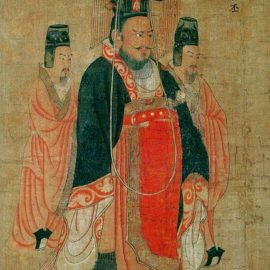

This article is an excerpt from the Shortform summary of "Killers of the Flower Moon" by David Grann. Shortform has the world's best summaries of books you should be reading.
Like this article? Sign up for a free trial here .
What’s the history of the forced assimilation of Native Americans? Did it play a role in the Osage murders of the 1920s?
Forced assimilation was a system that stripped Native Americans of their lands and culture. The practice contributed to the conspiracy to rob the Osage of their material wealth, and it ultimately led to many murders.
Continue reading to learn about the forced assimilation of the Osage people.
Forced Assimilation of the Osage Nation
In the late 19th century, the Osage Nation, a Native American tribe of the Great Plains, unexpectedly became one of the wealthiest per-capita groups in the world. Military incursions by the U.S. Army and land expropriation by white settlers over the course of the century had confined the Osage people to a reservation in a small corner of northern Oklahoma, a sliver of their once-extensive tribal territory. This was part of the forced assimilation campaign.
The forced migration brought poverty, sickness, and misery—by the 1870s, the population of the tribe was a mere 3,000, just a third of what it had been at the dawn of the 19th century, with many people succumbing to smallpox and violent attacks by white settlers. But when oil was discovered in Osage County, Oklahoma, in 1897, the Osage were suddenly rich beyond their wildest dreams, with the total tribal income from oil leases running into the tens of millions.
But what is the forced assimilation of Native Americans? Not only were the Osage financially expropriated by whites—they were systematically robbed of their culture as well. In the late 19th and early 20th centuries, the United States Department of the Interior was responsible for the governance of Indian territories and greatly controlled the lives of those under its jurisdiction.
Official government policy stipulated that native peoples like the Osage were morally and culturally unfit for self-government, and needed to be taught the ways of the white man in order to fully participate in American economic and political life. In Oklahoma, the federal government ran a program of forced assimilation, the goal of which was to wipe out any traces of Osage religion and language. The economic foundations of tribal life had already been unmoored by the near-extinction of the buffalo herds of the Great Plains, which had been the main food and fuel supply of Plains Indians like the Osage. The Department of the Interior compelled the tribe to adopt agriculture. Mass starvation was the result of this involuntary social engineering, as the Osage were unprepared to survive in an economy based on sedentary farming and private property.
When you ask yourself what forced assimilation is, it’s important to understand that the program had several approaches. The program of forced assimilation of Native Americans was especially targeted at children. Young Osage were forced to attend schools (often Christian parochial schools), where they would be taught to reject traditional Osage religion and culture and be remade in the white man’s image. These schools were English-only—children were not allowed to speak the language of their ancestors inside the walls of these schools, which were often harsh and grim. The children were also forced to conform to white society’s ideal of the “proper” social and economic roles for men and women, roles that applied far more to a settled, agricultural economic system (like that of European-Americans) than a semi-nomadic, hunting-based economic system (like that of most American Indians). Thus, Osage boys were taught farming and carpentry; girls were taught sewing, baking, laundering, and housekeeping. Those who tried to escape were dragged back by force.
The traditional culture of the Osage began to fade away and die, as generations of children were subjected to this regime of forced cultural assimilation. By the early 1920s, speakers of the Osage tongue were dwindling, traditional modes of dress had all but disappeared, and most members of the tribe had converted to Christianity, with only faint vestiges of the old religion still observed.
It was in this context of coveted wealth, financial exploitation, and cultural change that the Osage murders took place. The Reign of Terror, as it became known, made headlines around the world and left a permanent mark on the psyche of the Osage Nation. The murders also helped to transform the practice and public image of law enforcement in the United States, providing the impetus for the creation of the Federal Bureau of Investigation.
The forced assimilation of Native Americans was a system of laws and policies that lasted throughout much of American history. The Osage murders continue to be emblematic of these policies, and their far-reaching effects.

———End of Preview———
Like what you just read? Read the rest of the world's best summary of David Grann's "Killers of the Flower Moon" at Shortform .
Here's what you'll find in our full Killers of the Flower Moon summary :
- How the Osage tribe had vast oil wealth, but had it seized by their murderous neighbors
- The brutal and unresolved murders of Osage Native Americans
- The complicated history of the FBI in profiting from the Osage murders






